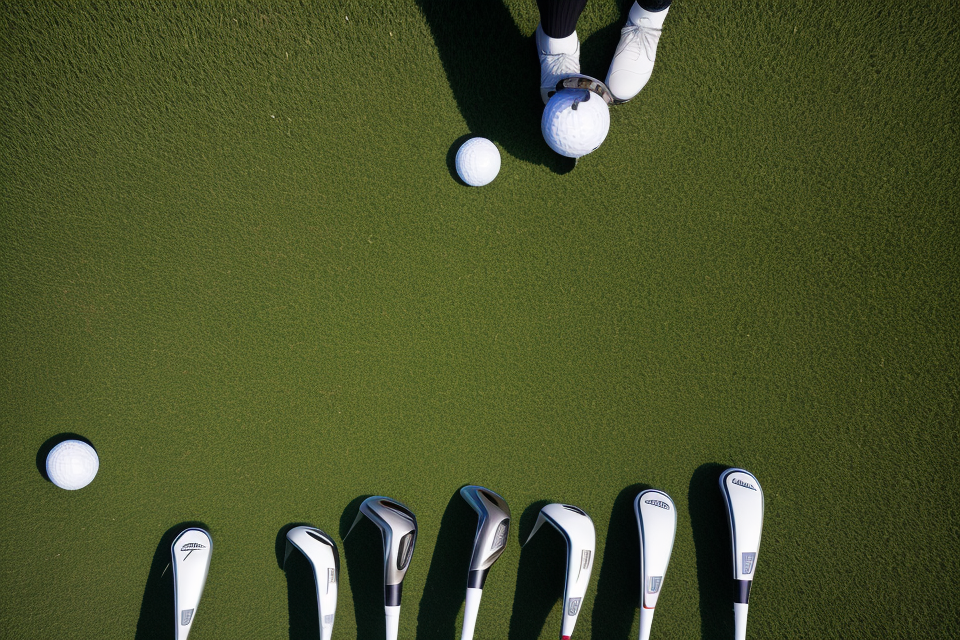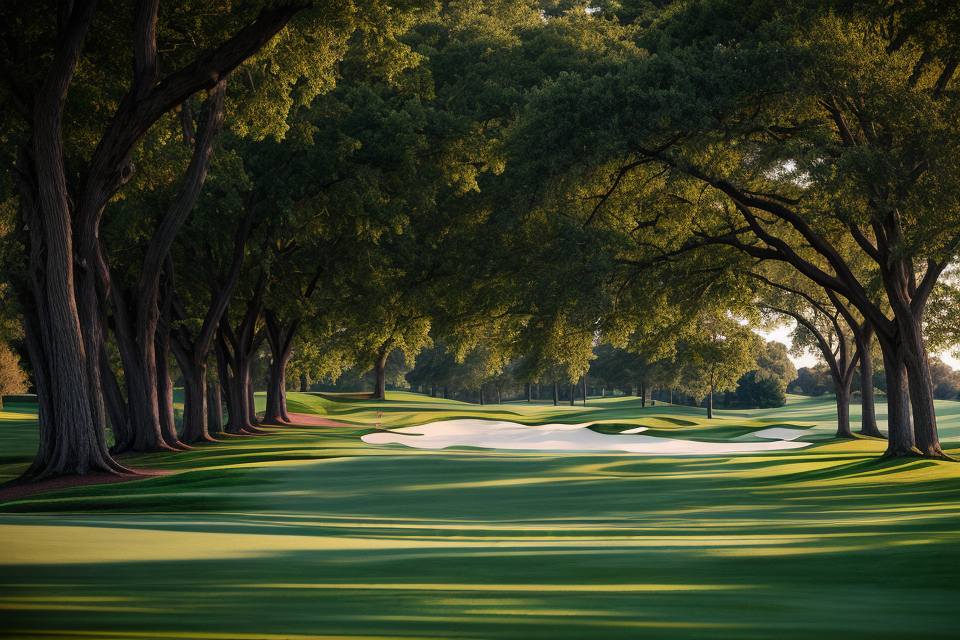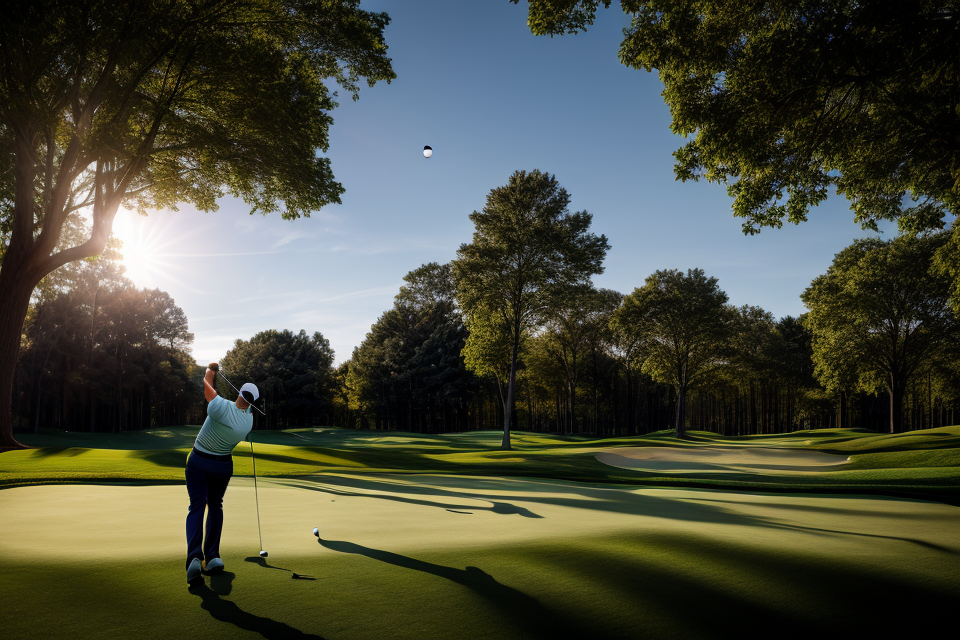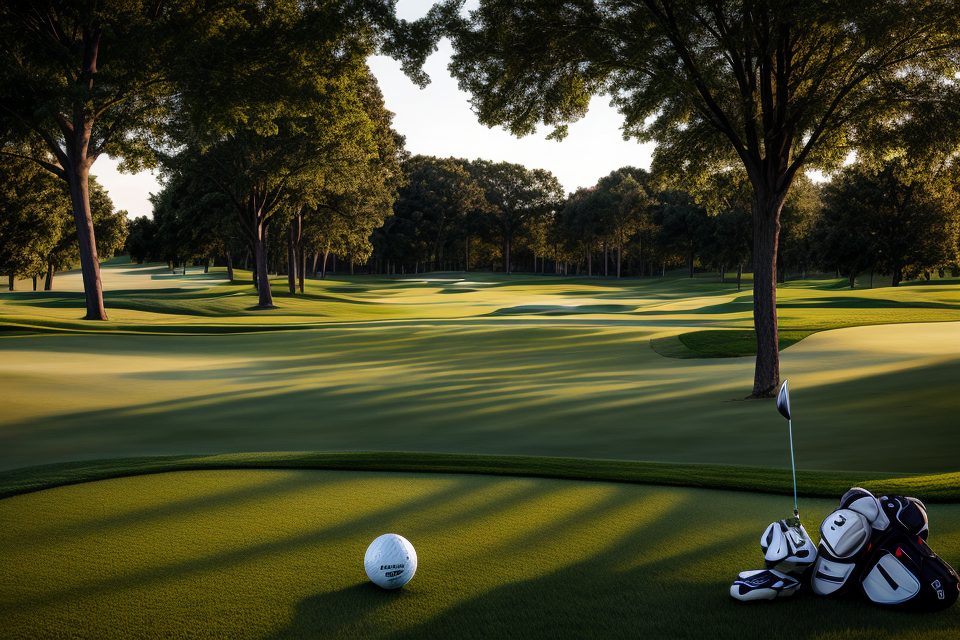
Golf is a sport that requires precision and accuracy, and one of the most crucial factors in achieving these qualities is the type of golf club you use. Some players believe that the type of golf club doesn’t matter, while others swear by their favorite clubs. But the truth is, the type of golf club you use can have a significant impact on your game. In this comprehensive guide, we will explore the various types of golf clubs available, their features, and how they can affect your performance on the course. Whether you’re a seasoned pro or a beginner, this guide will provide you with valuable insights into the world of golf club selection and help you make informed decisions about your equipment. So, let’s dive in and discover the fascinating world of golf clubs!
Understanding the Basics of Golf Clubs
The Anatomy of a Golf Club
The golf club is the most crucial component of the game, as it is the tool that strikes the ball. It is composed of three main parts: the grip, the shaft, and the clubhead. Understanding the anatomy of a golf club is essential for selecting the right club for your game and improving your performance on the course.
Grip
The grip is the part of the golf club that you hold in your hands while swinging. It is usually made of rubber or cord and is designed to provide a comfortable and secure grip on the club. The grip can be customized to fit the player’s preferences, such as the size, shape, and texture. A good grip should be firm but not too tight, as it can cause fatigue and reduce control over the club.
Shaft
The shaft is the long, flexible part of the golf club that connects the grip to the clubhead. It is usually made of graphite or steel and is designed to provide both power and control to the player. The shaft is an essential component of the golf club, as it determines the ball’s trajectory and distance. Different shafts are designed for different types of players, such as beginners, intermediate, and advanced players.
Clubhead
The clubhead is the part of the golf club that strikes the ball. It is usually made of metal or a composite material and is designed to provide both power and control to the player. The clubhead’s size and shape can affect the ball’s trajectory and distance. Different clubs have different clubhead designs, such as drivers, fairway woods, hybrids, irons, and wedges. Each club has a specific purpose and is designed to be used in different situations on the course.
Understanding the anatomy of a golf club is essential for selecting the right club for your game and improving your performance on the course. Each part of the golf club plays a crucial role in the player’s swing and shot selection. By understanding the basics of golf clubs, you can make informed decisions when purchasing new equipment and improve your game on the course.
The Importance of Club Length and Loft
When it comes to golf clubs, the length and loft of the club can greatly impact your game. In this section, we will discuss the importance of club length and loft and how they can affect your swing speed and accuracy, as well as ball trajectory and distance.
Club Length and Swing Speed
The length of a golf club can greatly impact your swing speed. A longer club will generally result in a slower swing speed, while a shorter club will result in a faster swing speed. This is because a longer club requires more effort to swing, which can slow down your swing speed.
Club Length and Accuracy
In addition to swing speed, the length of a golf club can also impact your accuracy. A longer club can make it more difficult to maintain control and accuracy during your swing, particularly for those with slower swing speeds. On the other hand, a shorter club can make it easier to maintain control and accuracy, particularly for those with faster swing speeds.
Club Loft and Ball Trajectory
The loft of a golf club can greatly impact the ball trajectory and distance. A higher lofted club will result in a higher ball trajectory, which can help to increase distance and accuracy. Conversely, a lower lofted club will result in a lower ball trajectory, which can decrease distance and accuracy.
Club Loft and Ball Spin
In addition to ball trajectory, the loft of a golf club can also impact the amount of spin placed on the ball. A higher lofted club will generally result in less spin, which can help to reduce the amount of side spin and backspin on the ball, resulting in more accurate shots.
In conclusion, the length and loft of a golf club can greatly impact your game. By understanding the importance of club length and loft, you can make informed decisions when selecting the right clubs for your game, resulting in improved accuracy and distance.
Choosing the Right Clubs for Your Game
Selecting the right golf clubs is crucial to improving your game. To make the best decision, consider the following factors:
- Your playing style: Each golfer has a unique playing style, and it’s essential to choose clubs that complement it. If you have a flat swing, you might benefit from a higher lofted driver or fairway wood. On the other hand, if you have a steep angle of attack, you might prefer a lower lofted club.
- Course conditions: The condition of the course can affect your club selection. For example, if the course has narrow fairways, you might want to choose a more forgiving driver or fairway wood. If the course has thick rough, you might want to opt for a lower lofted iron or hybrid to help you get out of trouble.
- Distance and accuracy: Assess your distance and accuracy with each club to determine the best set for your game. Consider factors such as ball speed, spin rate, and launch angle to optimize your performance.
- Budget: Golf clubs can vary widely in price, so it’s important to choose clubs that fit your budget while still meeting your needs. Look for value-driven options that offer quality performance without breaking the bank.
Customizing your bag to your playing style is also essential. As you become more proficient, you may find that certain clubs work better for you than others. Don’t be afraid to experiment with different clubs and combinations to find the ones that work best for your game.
The Role of Golf Clubs in Improving Your Game
How Different Clubs Affect Ball Flight
Golf clubs play a crucial role in shaping the trajectory and distance of your shots. Each club type has a unique design and purpose, which affects the ball’s flight in distinct ways. Understanding these differences is essential for making informed shot selections and improving your overall game.
Drivers
Drivers are the longest and most lofted clubs in a golfer’s bag, designed to launch the ball high and far. Their large clubheads and low degrees of loft create a powerful, straight ball flight that travels a long distance.
Irons
Irons, also known as wood clubs, have a lower loft and are used for shorter, more precise shots. The loft of the iron affects the ball’s trajectory, with lower lofts resulting in a lower, more penetrating ball flight, and higher lofts producing a higher, more shallow ball flight.
Wedges
Wedges are specialized irons with varying degrees of loft, designed for controlling shots around the green. Their higher lofts create a more controlled, spinner-like ball flight, enabling players to stop the ball on the green or execute precise chip shots.
Putters
Putters are the least lofted clubs, designed specifically for rolling the ball on the green. The distinctive flat face and straight shaft help players make accurate, short strokes, keeping the ball on its intended line.
Understanding Ball Flight for Better Shot Selection
To improve your game, it’s essential to understand how different clubs affect ball flight. This knowledge will help you make informed decisions about which club to use in various situations, ultimately leading to more successful shots and lower scores. By selecting the right club for each shot, you can take advantage of the unique characteristics of each club, allowing you to shape your shots and control their trajectory more effectively.
Developing a Solid Contact and Consistent Ball Striking
Golf clubs play a crucial role in helping golfers develop a solid contact and consistent ball striking. This section will explore the role of golf club technology in improving ball striking and the importance of ball position and alignment for consistent contact.
The Role of Golf Club Technology in Improving Ball Striking
The design and technology of golf clubs have a significant impact on the ability of golfers to make solid contact with the ball and achieve consistent ball striking. Some of the key technological features that affect ball striking include:
- Clubhead speed: The speed at which the clubhead moves through the ball can have a significant impact on the ball’s trajectory and distance. Golfers who are able to generate higher clubhead speeds are more likely to achieve greater distance and accuracy.
- Clubhead design: The shape and size of the clubhead can affect the golfer’s ability to make solid contact with the ball. Clubheads with a larger sweet spot can help golfers make solid contact even if they don’t hit the ball in the center of the clubface.
- Shaft design: The shaft’s flexibility and stiffness can also affect ball striking. Golfers who use flexible shafts may find it easier to make solid contact with the ball, while stiffer shafts may help increase clubhead speed and distance.
The Importance of Ball Position and Alignment for Consistent Contact
In addition to the technology of the golf clubs, the position of the ball and the golfer’s alignment can also have a significant impact on their ability to make solid contact with the ball. Some key factors to consider include:
- Ball position: The position of the ball on the tee or in the fairway can affect the golfer’s ability to make solid contact. Golfers who are able to position the ball in the center of their stance are more likely to make solid contact with the ball.
- Alignment: The golfer’s alignment with the target can also affect their ability to make solid contact with the ball. Golfers who are able to align their body and clubface correctly are more likely to make solid contact and achieve consistent ball striking.
Overall, the technology of golf clubs and the golfer’s ability to position the ball and align their body and clubface correctly can all have a significant impact on their ability to make solid contact with the ball and achieve consistent ball striking.
Increasing Distance and Accuracy
When it comes to improving your game, one of the most important factors to consider is the type of golf club you use. Different golf clubs are designed to perform specific tasks, and selecting the right club can make a significant difference in your ability to hit the ball with power and accuracy. In this section, we will explore the science behind increasing distance and accuracy and the impact of swing speed, ball speed, and spin rate on these factors.
The Science Behind Increasing Distance and Accuracy
In order to increase distance and accuracy, there are several key factors to consider. The first is swing speed, which is the speed at which the club head is moving when it makes contact with the ball. Swing speed is a critical factor in determining how far the ball will travel, as well as the accuracy of the shot.
Another important factor is ball speed, which is the speed of the ball immediately after it is struck by the club. Ball speed is determined by the combined effects of the club head speed and the angle of attack, which is the angle at which the club head strikes the ball.
Finally, spin rate is also an important factor in determining the distance and accuracy of a shot. Spin rate is the rate at which the ball spins as it travels through the air, and it can have a significant impact on the trajectory and movement of the ball.
The Impact of Swing Speed, Ball Speed, and Spin Rate on Distance and Accuracy
The impact of these factors on distance and accuracy cannot be overstated. For example, a higher swing speed can result in a higher ball speed, which can translate into increased distance. Additionally, a higher spin rate can result in a more stable ball flight, which can improve accuracy.
On the other hand, a lower spin rate can result in a more erratic ball flight, which can negatively impact both distance and accuracy.
Ultimately, the right combination of swing speed, ball speed, and spin rate can help you hit the ball with power and accuracy, and selecting the right golf club can play a critical role in achieving these goals.
The Impact of Golf Clubs on Your Swing
Understanding the Biomechanics of the Golf Swing
Golf is a game that requires precision and accuracy, and the biomechanics of the golf swing plays a crucial role in determining the outcome of each shot. To fully understand the impact of golf clubs on your swing, it is important to have a basic understanding of the biomechanics of the golf swing.
The golf swing is a complex movement that involves the coordination of several different muscle groups, including the arms, legs, and core. Proper body alignment and kinematics are essential for maximizing power and accuracy, and different golf clubs can have a significant impact on these factors.
In this section, we will delve into the biomechanics of the golf swing and explore how different golf clubs can affect your swing.
The Importance of Proper Body Alignment and Kinematics
Proper body alignment and kinematics are crucial for maximizing power and accuracy in the golf swing. When the body is aligned correctly, it allows for a more efficient transfer of energy from the lower body to the upper body, resulting in greater power and distance.
One of the most important aspects of body alignment is the position of the feet. Golfers should aim to stand with their feet shoulder-width apart, with the balls of their feet facing forward. This position allows for proper weight distribution and a stable base, which is essential for maintaining balance and control throughout the swing.
Another important aspect of body alignment is the position of the hands. Golfers should hold the club with their hands slightly ahead of the ball, with the palms facing the target. This position allows for greater control and accuracy, as well as a more natural swing path.
How Different Golf Clubs Affect Your Swing
Different golf clubs can have a significant impact on the biomechanics of the golf swing. For example, longer clubs like drivers and fairway woods require a more circular swing path, while shorter clubs like wedges require a more abbreviated swing path.
In addition to affecting the swing path, different golf clubs can also impact the speed and power of the swing. For example, drivers and fairway woods are typically made from more flexible materials, which allows them to generate greater speed and distance. On the other hand, wedges are typically made from more dense materials, which makes them more accurate but less powerful.
Understanding the biomechanics of the golf swing and how different golf clubs can affect your swing is essential for maximizing power and accuracy on the course. By selecting the right clubs for your game and making adjustments to your swing based on the club you are using, you can improve your overall performance and enjoy more success on the golf course.
Improving Your Swing Through Club Selection
When it comes to improving your swing, one of the most effective ways to do so is through club selection. Golf clubs are designed to help you optimize your swing mechanics, and choosing the right ones can have a significant impact on your game. Here’s how customizing your swing with the right golf clubs can help you improve your overall performance.
The role of golf clubs in improving swing mechanics
Golf clubs are designed to help you hit the ball further and straighter, and they do so by optimizing your swing mechanics. The shaft, clubhead, and grip all work together to help you make solid contact with the ball, and each component is designed to help you achieve a specific result. For example, a driver is designed to help you hit the ball farther, while a putter is designed to help you make more accurate contact with the ball on the green.
Customizing your swing with the right golf clubs
In order to improve your swing, it’s important to choose the right golf clubs for your game. This means taking into account your physical attributes, swing style, and the conditions on the course. Here are some tips for customizing your swing with the right golf clubs:
- Choose the right shaft flex: The shaft flex of your golf club should be tailored to your swing speed and strength. If you have a slow swing speed, you’ll want to choose a more flexible shaft, while a stiffer shaft is better suited for players with a faster swing speed.
- Consider the length of your club: The length of your golf club should be chosen based on your height and arm length. Taller players may benefit from longer clubs, while shorter players may prefer clubs that are more compact.
- Select the right loft: The loft of your golf club affects the height and distance of your shots. Choose a club with the right loft for your swing type and the conditions on the course.
- Try different grips: The grip of your golf club can also affect your swing mechanics. Experiment with different grip sizes and materials to find the one that feels most comfortable and natural for you.
By customizing your swing with the right golf clubs, you can improve your overall performance on the course. Experiment with different clubs and make adjustments based on your physical attributes and the conditions on the course to find the right combination for your game.
FAQs
1. Does the type of golf club really matter?
Answer:
The type of golf club you use can have a significant impact on your game. Different clubs are designed for different shots and playing conditions, so choosing the right club can help you hit the ball further, straighter, and more accurately.
2. What factors should I consider when choosing a golf club?
When choosing a golf club, there are several factors to consider. First, think about your skill level and the type of shots you need to hit. For example, if you’re a beginner, you may want to choose a more forgiving club that’s easier to hit. Next, consider the playing conditions, such as the course conditions, wind, and temperature. Finally, think about your personal preferences, such as the feel of the club, the shaft flex, and the grip size.
3. Can I use the same golf club for every shot?
While it’s possible to use the same golf club for every shot, it’s not recommended. Different clubs are designed for different shots, and using the wrong club can lead to poor contact, inconsistent ball flight, and even injury. For example, using a driver for a chip shot or a putter for a full swing can result in poor contact and reduced distance.
4. How often should I replace my golf clubs?
The frequency with which you should replace your golf clubs depends on several factors, including your skill level, the condition of your clubs, and your personal preferences. Generally, golf clubs can last for several years if they are well-maintained and properly cared for. However, if you’re a high-level golfer or if your clubs are showing signs of wear and tear, you may want to consider replacing them more frequently.
5. What are the most important golf clubs in my bag?
The most important golf clubs in your bag are the ones that allow you to hit a variety of shots and play different courses effectively. This typically includes a driver, fairway woods, hybrids, irons, and a putter. However, the specific clubs you need will depend on your skill level, the courses you play, and your personal preferences.


